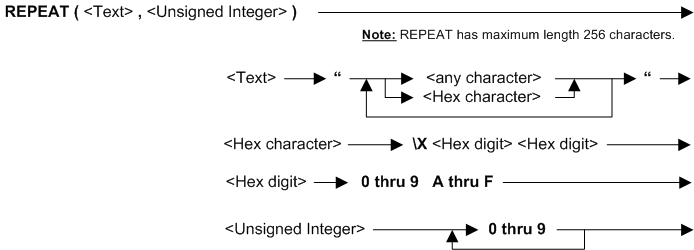Function REPEAT
TABLE OF CONTENTS
- How do I use REPEAT?
- Syntax
- Rules for the syntax
- Examples: REPEAT function in ERF
- Examples: REPEAT function in ECL
How do I use REPEAT?
If you provide a text string and an integer, then REPEAT can create a string that consists of the given text string with integer repetitions. REPEAT is different from ALL because REPEAT has a fixed number of repetitions, whereas ALL is flexible and compares with fields of different lengths.
REPEAT can only be used in Extract Record Filter (ERF) and Extract Column Logic (ECL) text.

Syntax

Rules for the syntax
REPEAT has a maximum length of 256 characters.
REPEAT can only be used in Extract Record Filter (ERF) and Extract Column Logic (ECL) text.
See also topic: Rules for all Logic Text
Examples: REPEAT function in ERF
| Example logic text | Meaning |
|---|---|
| IF NOT ({field7} = REPEAT(“-“, 13)) THEN SELECT ENDIF |
Select for output those records with field7 is not equal to 13 dashes. This example is the same as: SKIPIF({field7} = REPEAT(“-“, 13)) |
| IF ({field8} = REPEAT(“-“, 13)) THEN SKIP ENDIF |
Skip for output those records with field8 is equal to 13 dashes. Select all other records. This example is the same as: SKIPIF({field8} = REPEAT(“-“, 13)) |
Examples: REPEAT function in ECL
| Example logic text | Meaning |
|---|---|
| IF ({field9} = “Total”) THEN COLUMN = REPEAT(“-“, 13) ENDIF |
If field9 is “Total” then set the current column to 13 dashes. |
| IF ({field10} = REPEAT(“-“, 13)) THEN COLUMN = {field1} + {field2} ENDIF |
If field10 is 13 dashes, then set the current column to a total of fields 1 and 2. |